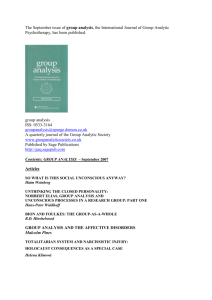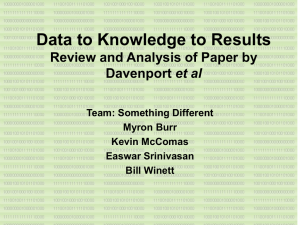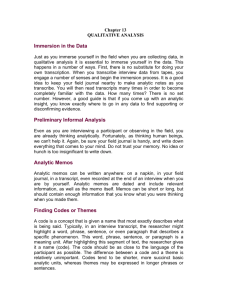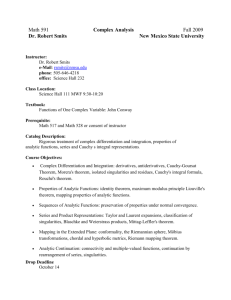Proving the Prime Number Theorem in an hour
advertisement
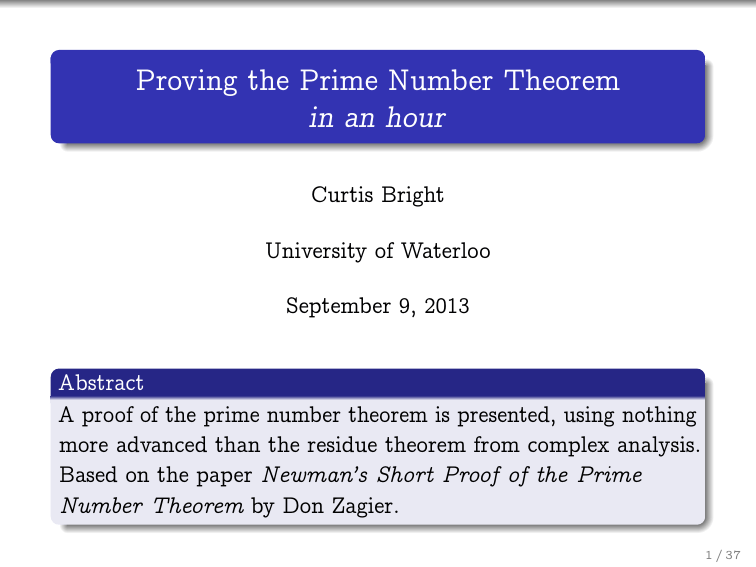
Proving the Prime Number Theorem
in an hour
Curtis Bright
University of Waterloo
September 9, 2013
Abstract
A proof of the prime number theorem is presented, using nothing
more advanced than the residue theorem from complex analysis.
Based on the paper Newman’s Short Proof of the Prime
Number Theorem by Don Zagier.
1 / 37
The statement
P
Let π(x ) count the primes 6 x , i.e., π(x ) := p6x 1.
The Prime Number Theorem states that
. x = 1.
lim π(x )
x →∞
ln x
The simplest proofs require the use of complex numbers!
Notation
Throughout let z = x + iy be a complex number with x , y
real, and let p be prime.
2 / 37
Analytic functions
Complex differentiable functions are known as analytic.
We will be concerned with functions defined by
well-behaved limiting processes.
Wherever the limit converges the functions will be analytic.
Even if the limit doesn’t converge, the function can
sometimes still be defined using analytic continuation.
3 / 37
Zeros and poles
Let f (z ) be analytic around α ∈ C. We can uniquely
represent f around α by a Laurent series
f (z ) =
∞
X
cn (z − α)n .
n=−∞
Let Ordf (α) denote the minimal n such that cn 6= 0.
When Ordf (α) > 0, α is known as a zero.
When Ordf (α) < 0, α is known as a pole, and if
Ordf (α) = −1, α is known as a simple pole.
Resf (α) := c−1 is known as the residue of the pole at α.
For simple poles, Resf (α) = limz →α (z − α)f (z ).
4 / 37
M-L inequality
The maximum times length (M-L) estimate is a simple way
of bounding the absolute value of integrals:
Z
f (z ) dz 6 M len(C )
C
where |f (z )| 6 M for z on C .
5 / 37
Cauchy’s residue theorem
Let C be a counterclockwise circle containing α, and let
f (z ) be analytic on and within C , except for a pole at α.
C
α
Cauchy’s residue theorem states that
Z
f (z ) dz = 2πi Resf (α).
C
In addition, C can be freely deformed in the analytic region.
6 / 37
Absolute value of complex exponentials
To compute the norm of n z , replace z with its real part:
|n z | = e (x +iy) ln n = e x ln n |cos(y ln n) + i sin(y ln n)|
q
x
=n
cos2 (y ln n) + sin2 (y ln n)
= nx
7 / 37
Four important functions
∞
X
1
ζ(z ) :=
z
n
n=1
Φ(z ) :=
X ln p
p
ϑ(x ) :=
X
pz
ln p
p6x
π(x ) :=
X
1
p6x
8 / 37
Convergence of ζ(z ) and Φ(z )
ζ(z ) converges absolutely for x > 1 by the integral test:
Z∞
∞ ∞
X
du
x
1 X 1
.
6
1
+
=
z=
x
x
n
n
x −1
1 u
n=1
n=1
Similarly, Φ(z ) converges absolutely for x > 1.
The region of convergence for ζ(z ) and Φ(z ):
x >1
9 / 37
Main steps of the proof
Setup
Q
I ζ(z ) = p (1 − 1/p z )−1 for x > 1
II ζ(z ) is analytic for x > 1, except for a simple pole at z = 1
III Φ(z ) is analytic for x > 1, except for a simple pole at z = 1
IV ϑ(x ) = O(x )
Analytic Theorem
R∞
V If |f (t )| is bounded and 0 f (t )e −zt dt can be analytically
R∞
continued to x = 0 then 0 f (t ) dt converges
VI
VII
VIII
Downhill
R∞ ϑ(x )−x
1
x2
dx converges
)
limx →∞ ϑ(x
x =1
)
limx →∞ xπ(x
/ ln x = 1
10 / 37
I. ζ(z ) =
Q
p (1
− 1/p z )−1 for x > 1
Euler discovered a beautiful relation between ζ(z ) and the
primes:
∞
X
Y
1
1
=
z
n
1 − 1/p z
p
n=1
11 / 37
I. ζ(z ) =
Q
p (1
− 1/p z )−1 for x > 1
Use the geometric series formula with ratio 1/p z :
Y
p
YX 1
1
=
1 − 1/p z
p kz
p
k >0
Multiplying the first two factors:
X
X 1 X 1
1
·
=
kz
kz
k
1
2
3
(2 3k2 )z
k >0
k >0
k1 ,k2 >0
Continue multiplying together the factors to obtain:
X
k1 ,k2 ,k3 ,...>0
1
(2k1 3k2 5k3
· · · )z
By rearranging terms and using unique factorization, this is
P
equal to n>1 1/n z .
12 / 37
II. ζ(z ) is analytic for x > 1, except for a simple pole at z = 1
We want to show that ζ(z ) admits an analytic continuation
to the line x = 1.
Actually, this isn’t possible because of a pole at z = 1.
However, by “subtracting off” the pole, as in
ζ(z ) −
1
,
z −1
then the analytic continuation to x = 1 works.
13 / 37
II. ζ(z ) is analytic for x > 1, except for a simple pole at z = 1
For x > 1 we have
Z∞
∞
∞ Z n+1
X
X
1
1
du
1
1
ζ(z ) −
=
−
=
− z du.
z
z
z
z − 1 n=1 n
n
u
1 u
n=1 n
The absolute value of this summand is at most
1
Z u z dv 1 max − z = max u
u∈[n,n+1] n z
u∈[n,n+1] n v z +1
z 6 max
max z +1 u∈[n,n+1] v ∈[n,u] v
|z |
= x +1 .
n
Employing the M-L inequality twice.
P
|
By comparison with n>1 n|zx +1
, the sum on the right
converges absolutely for x > 0.
14 / 37
III. Φ(z ) is analytic for x > 1, except for a simple pole at z = 1
Taking the logarithmic derivative of the Euler product:
X ln p/p z
ζ 0 (z )
d
=
ln ζ(z ) = −
= −Φ(z ) − A(z )
ζ(z )
dz
1 − 1/p z
p
where A(z ) :=
P
ln p
p p z (p z −1)
is analytic for x > 1/2.
The logarithmic derivative has an especially simple Laurent
expansion around α:
ζ 0 (z )
Ordζ (α)
=
+ O(1)
ζ(z )
z −α
It follows ResΦ (α) = − Ordζ (α).
To show Φ is analytic at α, we show Ordζ (α) = 0.
15 / 37
III. Φ(z ) is analytic for x > 1, except for a simple pole at z = 1
From
X ln p
lim+ = ResΦ (z )
p z +
→0
p
one gets that
lim+ →0
X ln p
(p 2yi + 4p yi + 6 + 4p −yi + p −2yi )
x +
p
p
= ResΦ (x − 2yi ) + 4 ResΦ (x − yi ) + 6 ResΦ (x ) + 4 ResΦ (x + yi ) + ResΦ (x + 2yi )
= 2 ResΦ (x + 2yi ) + 8 ResΦ (x + yi ) + 6 ResΦ (x )
The residues of Φ being invariant under complex
conjugation being a consequence of Φ(z ) = Φ(z ).
The ugly factor simplifies to (p yi /2 + p −yi /2 )4 .
Nonnegative since its inside is real.
16 / 37
III. Φ(z ) is analytic for x > 1, except for a simple pole at z = 1
Then
X ln p
(p yi /2 + p −yi /2 )4 > 0
x +
p
p
and, taking the limit as → 0+ , we have
2 ResΦ (x + 2yi ) + 8 ResΦ (x + yi ) + 6 ResΦ (x ) > 0
2 Ordζ (x + 2iy) + 8 Ordζ (x + iy) + 6 Ordζ (x ) 6 0
Making use of ResΦ (z ) = − Ordζ (z ).
17 / 37
III. Φ(z ) is analytic for x > 1, except for a simple pole at z = 1
Using Ordζ (z ) > −1, this becomes
2 Ordζ (x + 2iy) + 8 Ordζ (x + iy) 6 6.
For x > 1 and z 6= 1 we know ζ(z ) has no poles, so
Ordζ (z ) > 0.
Combining the above two inequalities, we have
Ordζ (x + iy) = 0.
Thus Φ(z ) is analytic for x > 1 and z 6= 1.
Φ(1) is a simple pole with residue − Ordζ (1) = 1.
18 / 37
IV. ϑ(x ) = O(x )
The binomial theorem gives the following upper bound on
the central binomial coefficient:
X
2n 2n
2n
6
= (1 + 1)2n = 4n
n
k
k =0
But every prime n < p 6 2n is a factor of (2n)!/(n!)2 :
X
Y
X
2n
>
p = exp
ln p −
ln p
n
n<p62n
p62n
p6n
= exp(ϑ(2n) − ϑ(n))
19 / 37
IV. ϑ(x ) = O(x )
Combining these and taking the logarithm,
ϑ(2n) − ϑ(n) 6 n ln 4.
If n is a power of 2, summing this over n, n/2, . . . , 1 the
left side telescopes and the right side is a truncated
geometric series:
ϑ(2n) 6 (n + n/2 + · · · + 1) ln 4 6 2n ln 4
For arbitrary x , let n 6 x < 2n where n is a power of 2.
Then:
ϑ(x ) 6 ϑ(2n) 6 2n ln 4 6 2x ln 4
20 / 37
V. Analytic Theorem - The statement
If |f (t )| is bounded (say by M ) and its Laplace transform
Z∞
f (t )e −zt dt
0
defines an analytic function g(z ) for x > 0, then the integral
converges for z = 0.
V. Analytic Theorem - Easy convergence
Note the integral converges absolutely for x > 0 since
Z∞
Z∞
M
f (t )e −zt dt 6 M
e −xt dt =
.
x
0
0
21 / 37
V. Analytic Theorem - Setup
Define the ‘truncated’ Laplace transform,
ZT
f (t )e −zt dt .
gT (z ) :=
0
This is analytic for all z by differentiation under the integral
sign. As T → ∞ this converges to g(z ) for x > 0.
We will show this also occurs at z = 0, i.e.,
ZT
lim
T →∞ 0
f (t ) dt = g(0).
22 / 37
V. Analytic Theorem - A useful function
Consider the function
1
z + 2 .
g(z ) − gT (z ) e zT
z
R
This is analytic for x > 0 and z 6= 0, since:
g(z ) − gT (z ) is analytic for x > 0
e zT is analytic for all z
1/z + z /R 2 is analytic for z 6= 0
At z = 0, this has a simple pole with residue g(0) − gT (0).
V. Analytic Theorem - A useful fact
On the circle |z | = R, the final factor is equal to
x + yi
2x
x − yi
+ 2
= 2.
2
2
2
x +y
x +y
R
23 / 37
V. Analytic Theorem - A useful contour
Define the contour D in the complex plane by:
D
R
Here (depending on R) is taken small enough so that g(z )
is analytic on and inside D.
By Cauchy’s residue theorem,
Z
1
z g(z ) − gT (z ) e zT
+ 2 dz = 2πi g(0) − gT (0) .
z
R
D
24 / 37
V. Analytic Theorem - A useful integral
We split the integral
Z
1
z + 2 dz
I :=
g(z ) − gT (z ) e zT
z
R
D
into three such that I = I1 − I2 + I3 :
Z
I1 :=
D1
1
z + 2 dz
g(z ) − gT (z ) e zT
z
R
Z
gT (z )e zT
I2 :=
1
z
D2
Z
g(z )e zT
I3 :=
D3
1
z
+
+
z dz
R2
z dz
R2
D1
D2
D3
25 / 37
V. Analytic Theorem - The first integral
For x > 0, we have that |g(z ) − gT (z )| is equal to
Z∞
Z ∞
e −xT
e −xt dt = M
.
f (t )e −zt dt 6 M
x
T
T
Using M-L we can bound |I1 |:
Z
1
z + 2 dz g(z ) − gT (z ) e zT
z
R
D1
1
e −xT
2x
=
O
M
e xT
6 max πR
z ∈D1
x
R2
R
26 / 37
V. Analytic Theorem - The second integral
For x < 0, we have that |gT (z )| is equal to
ZT
Z T
e −xT − 1
e −xt dt = M
.
f (t )e −zt dt 6 M
|x |
0
0
Using M-L we can bound |I2 |:
Z
1
z gT (z ) e zT
+ 2 dz z
R
D2
1
e −xT xT
2|x |
=
O
6 max πR M
e
z ∈D2
|x |
R2
R
27 / 37
V. Analytic Theorem - The third integral
Since g(z ) z1 + Rz2 is analytic on D3 , its absolute value
must be bounded (say by B ).
We have |e zT | 6 1 for z on D3 , but this is not sufficient for
using M-L. Instead, we split D3 into a left and right part
based on a parameter δ ∈ (0, ):
δ
D3r
D3l
R
28 / 37
V. Analytic Theorem - The third integral
Using M-L on D3l and D3r separately we can bound |I3 |:
Z
1
z g(z )
+ 2 e zT dz z
R
C
for D3l : 6 2(R + )
B
e −δT
= O(e −δT )
for D3r : 6
2δ
B
1
= O(δ)
Taking the limit as T → ∞,
0 6 lim sup|I3 | 6 O(δ).
T →∞
Taking the limit as δ → 0+ ,
lim |I3 | = 0.
T →∞
29 / 37
V. Analytic Theorem - Conclusion
We have
I |g(0) − gT (0)| = 6 |I1 | + |I2 | + |I3 |.
2πi
Taking the limit as T → ∞,
0 6 lim sup|g(0) − gT (0)| 6 O
T →∞
1
.
R
Taking the limit as R → ∞,
lim |g(0) − gT (0)| = 0.
T →∞
Therefore
Z∞
f (t ) dt = g(0).
0
30 / 37
VI.
R∞
1
ϑ(x )−x
x2
dx converges
Note the Laplace transform of ϑ(e t ) is Φ(z )/z :
Z∞
Φ(z )
ϑ(e t )e −zt dt
=
z
0
This follows via summation by parts, algebra, and the
substitution u = e t :
∞
X
1
1
ϑ(n)
Φ(z ) =
ϑ(n)
−
+ lim
z
z
n→∞ n z
n
(n
+
1)
n=1
Z n+1
∞
X
z du
=
ϑ(n)
(x > 1)
z +1
u
n
n=1
Z∞
ϑ(u)
=z
du
z +1
u
1
31 / 37
VI.
R∞
1
ϑ(x )−x
x2
dx converges
R∞
Substituting z 7→ z + 1 and subtracting 1/z = 0 e −zt dt ,
this becomes:
Z ∞
Φ(z + 1) 1
ϑ(e t )
− =
−
1
e −zt dt
t
z +1
z
e
0
By III, the left hand side is analytic for x > 0, since
is analytic there.
Φ(z +1)
z +1
Except at z = 0, where it has a simple pole with residue
+1)
limz →0 z Φ(z
= 1.
z +1
By IV, the Laplace integrand is O(e t )/e t − 1 = O(1).
32 / 37
VI.
R∞
1
ϑ(x )−x
x2
dx converges
Using the analytic theorem with f (t ) := ϑ(e t )/e t − 1,
Z∞
Z∞
ϑ(e t )
ϑ(x ) − x
− 1 dt =
dx
t
e
x2
0
1
converges (the substitution x = e t was used).
This is a strong condition;
if ϑ(x ) = (1 + )x then this
R∞
integral would be 1 /x dx , which diverges.
33 / 37
VII. limx →∞
ϑ(x )
x
=1
Suppose otherwise. Then there is some > 0 such that
ϑ(x ) > (1 + )x or ϑ(x ) < (1 − )x for arbitrarily large x .
In the first case, say {xn } is an increasing sequence with
ϑ(xn ) > (1 + )xn . Since ϑ(x ) is non-decreasing,
Z (1+)xn
xn
ϑ(x ) − x
dx >
x2
Z (1+)xn
xn
(1 + )xn − x
dx
x2
= − ln(1 + )
which is a positive number not depending on n.
R∞
Since 1 ϑ(xx)−x
dx converges, the above sequence of
2
subintegrals should go to zero as n → ∞.
34 / 37
VII. limx →∞
ϑ(x )
x
=1
In the second case, say {xn } is an increasing sequence with
ϑ(xn ) < (1 − )xn . Since ϑ(x ) is non-decreasing,
Z xn
Z xn
ϑ(x ) − x
(1 − )xn − x
dx <
dx
2
x
x2
(1−)xn
(1−)xn
= + ln(1 − )
which is a negative number not depending on n.
R∞
Since 1 ϑ(xx)−x
dx converges, the above sequence of
2
subintegrals should go to zero as n → ∞.
Either case leads to a contradiction, so we must in fact have
)
limx →∞ ϑ(x
x = 1.
35 / 37
VIII. limx →∞
π(x )
x / ln x
=1
By multiplying the number of nonzero terms with the
maximum or minimum term one derives upper and lower
bounds on ϑ(x ) in terms of π(x ) ln x :
X
ϑ(x ) =
ln p 6 π(x ) ln x
p6x
ϑ(x ) >
X
ln p > π(x ) − π(x 1− ) ln(x 1− )
x 1− <p6x
For the lower bound, we ignore primes less than x 1− for
some constant parameter ∈ (0, 1).
36 / 37
VIII. limx →∞
π(x )
x / ln x
=1
Combining these,
ϑ(x )
π(x )
1 ϑ(x ) ln x
6
6
+ .
x
x / ln x
1− x
x
Taking the limit as x → ∞ and using limx →∞
1 6 lim sup
x →∞
ϑ(x )
x
= 1,
π(x )
1
6
.
x / ln x
1−
Similarly for the lim inf.
Taking the limit as → 0+ ,
π(x )
= 1.
x →∞ x / ln x
lim
37 / 37




